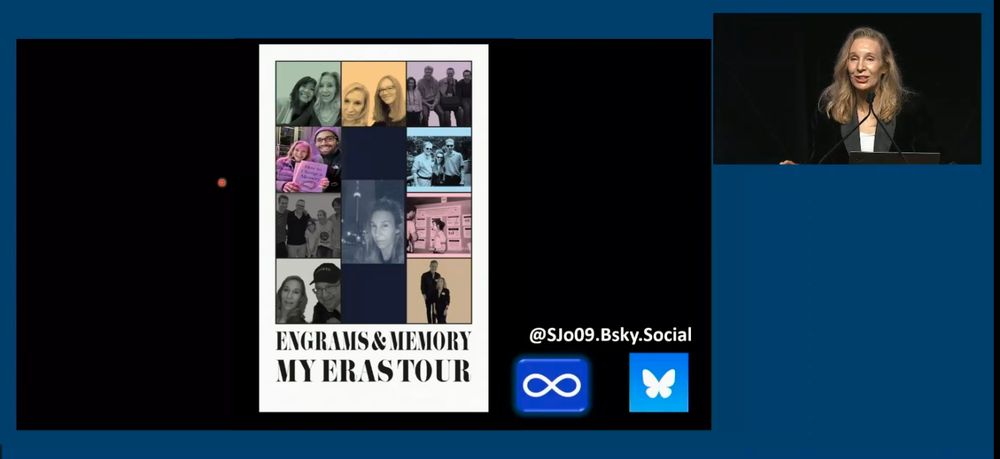EiC @elife.bsky.social
The renamed:
Bluesky-sized history of neuroscience (biased by my interests)



Find our Editor-in-Chief, Timothy Behrens, in room 4 for broad discussions on innovations in publishing: buff.ly/nF33AGT
#OpenScience #PhDChat #AcademicSky #ScholComm

Find our Editor-in-Chief, Timothy Behrens, in room 4 for broad discussions on innovations in publishing: buff.ly/nF33AGT
#OpenScience #PhDChat #AcademicSky #ScholComm
When we learn a category, do we learn the structure of the world, or just where to draw the line? In a cross-species study, we show that humans, rats & mice adapt optimally to changing sensory statistics, yet rely on fundamentally different learning algorithms.
www.biorxiv.org/content/10.1...

When we learn a category, do we learn the structure of the world, or just where to draw the line? In a cross-species study, we show that humans, rats & mice adapt optimally to changing sensory statistics, yet rely on fundamentally different learning algorithms.
www.biorxiv.org/content/10.1...



Saturday, Nov 15, 2:00-4:30pm, Room SDCC 6CF
www.abstractsonline.com/pp8/#!/21171...
We will explore how the PFC represents structured relationships across species and how this supports flexible behavior.

Saturday, Nov 15, 2:00-4:30pm, Room SDCC 6CF
www.abstractsonline.com/pp8/#!/21171...
We will explore how the PFC represents structured relationships across species and how this supports flexible behavior.

(1) Are the claims interesting/important?
(2) Does the evidence support the claims?
Most of my reviews these days are short and focused.
Find out why you should send your research to eLife: buff.ly/MJy9rBE

Find out why you should send your research to eLife: buff.ly/MJy9rBE

Come join my lab! Work on neuroscience and AI, explore your creativity, be independent or work closely with me, collaborate widely, and have a lot of fun!
my.corehr.com/pls/uoxrecru...
Come join my lab! Work on neuroscience and AI, explore your creativity, be independent or work closely with me, collaborate widely, and have a lot of fun!
my.corehr.com/pls/uoxrecru...
Whittington lab is live and hiring…
Come join my lab! Work on neuroscience and AI, explore your creativity, be independent or work closely with me, collaborate widely, and have a lot of fun!
my.corehr.com/pls/uoxrecru...
Whittington lab is live and hiring…
New blog post about @kristorpjensen.bsky.social awesome preprint.
New research from @kristorpjensen.bsky.social & colleagues proposes a ‘spacetime attractor’ model, showing that the brain may plan using the same principles it uses to fill in missing information about the present.
www.sainsburywellcome.org/web/blog/new...
www.biorxiv.org/content/10.1...
New blog post about @kristorpjensen.bsky.social awesome preprint.
New research from @kristorpjensen.bsky.social & colleagues proposes a ‘spacetime attractor’ model, showing that the brain may plan using the same principles it uses to fill in missing information about the present.
www.sainsburywellcome.org/web/blog/new...
www.biorxiv.org/content/10.1...
New research from @kristorpjensen.bsky.social & colleagues proposes a ‘spacetime attractor’ model, showing that the brain may plan using the same principles it uses to fill in missing information about the present.
www.sainsburywellcome.org/web/blog/new...
Deadline: 2nd December
1. Cross-species closed-loopTMR: tinyurl.com/bddu4tp6
2. TUS and TMR in humans:
tinyurl.com/jjws5ctj
Happy to chat to interested applicants.
Deadline: 2nd December
1. Cross-species closed-loopTMR: tinyurl.com/bddu4tp6
2. TUS and TMR in humans:
tinyurl.com/jjws5ctj
Happy to chat to interested applicants.
Apply for our MRC iCase studentship with @mkflugge.bsky.social, collabs with @lilweb.bsky.social + industrial placement at P1Vital:
www.medsci.ox.ac.uk/study/gradua...
Apply for our MRC iCase studentship with @mkflugge.bsky.social, collabs with @lilweb.bsky.social + industrial placement at P1Vital:
www.medsci.ox.ac.uk/study/gradua...
Applications are now open for 2026 entry to the Gatsby Unit & SWC joint PhD programme.
Join us and be part of a vibrant research community!
💰 Fully-funded 4-year programme
ℹ️ www.ucl.ac.uk/life-science...
@sainsburywellcome.bsky.social

Applications are now open for 2026 entry to the Gatsby Unit & SWC joint PhD programme.
Join us and be part of a vibrant research community!
💰 Fully-funded 4-year programme
ℹ️ www.ucl.ac.uk/life-science...
@sainsburywellcome.bsky.social
www.biorxiv.org/content/10.1...
www.biorxiv.org/content/10.1...
www.biorxiv.org/content/10.1...
Join us in London!
🧠 World-class neuroscience training
💰 Fully-funded 4-year programme
🖥️ Close links to @gatsbyucl.bsky.social
Apply by 3 Nov: www.sainsburywellcome.org/web/content/...
www.biorxiv.org/content/10.1...



